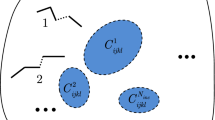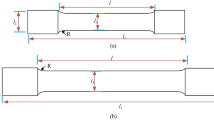Abstract.
In this paper, a two dimensional Voronoi cell element, formulated with creep, thermal and plastic strain, is applied for the numerical simulation of thermo-mechanical fatigue behavior for particulate reinforced composites. The relation between mechanical fatigue phases and thermal fatigue phases influences the thermo-mechanical fatigue behavior and cyclic creep damage. The topological features of micro-structure in particulate reinforced composites, such as the orientation, depth-width ratio, distribution and volume fraction of inclusions, have a great influence on thermo-mechanical behavior. Some related conclusions are obtained by examples of numerical simulation.
Similar content being viewed by others
References
Brechet, Y., Embury, JD., Tao, S. et al.: Damage initiation in metal matrix composites. Acta Metallurgica et Materialia, 39(8), 1781–1786 ( 1991)
Singh, PM., Lewandowski, JJ.: Damage evolution in discontinuously reinforced aluminum alloys. Metallurgical Transactions A. Physical Metallurgy and Materials, 24A, 2531 (1993)
Corbin, S., Wilkinson, D.: The influence of particle distribution on the mechanical response of particulate metal matrix composites. Acta Metallurgica et Materialia, 42, 1311–1318 (1994)
Bowles, CQ., Schijve, J.: The role of inclusions in fatigue crack initiation in an aluminum alloy. International Journal of Fracture, 9, 171–179 (1973)
Schmid, HK., Aslan, M., Assmann, S., Naß, R., Schmidt, H.: Microstructural characterization of Al2O3-SiC nano-composites. Journal of the European Ceramic Society, 18(1), 39–49 (1998)
Manson, SS.: Future directions for low cycle fatigue, in low cycle fatigue. ASTM STP 942, American Society for Testing and Materials, 1988 pp. 15–39
Miller, DA., Priest, RH.: Materials response to thermal-mechanical strain cycling. In: Skelton RP (ed.) High Temperature Fatigue Properties and Prediction, London, UK: Elsevier Applied Science Publisher Ltd, 1987 pp. 133–173
Eshelby, JD.: The determination of the elastic field of an ellipsoidal inclusion and related problems. Proc Roy Soc Lond, A241, 376–396 (1957)
Hill, R.: Elastic properties of reinforced solids: Some theoretical principles. Journal of the Mechanics and Physics of Solids, 11, 357–272 (1963)
Steinkopff, TH., Sautter, M.: Simulating the elasto-plastic behavior of multiphase materials by advanced finite element techniques, Part I: A rezoning technique and the multiphase element method. Computational Materials Science, 1, 10–14 (1995)
Steinkopff, TH., Sautter, M.: Simulating the elasto-plastic behavior of multiphase materials by advanced finite element techniques, Part II: Simulation of the deformation behavior of Ag-Ni composites. Computational Materials Science, 4(1), 15–22 (1995)
Zhang, J., Katsube, N.: A hybrid finite element method for heterogeneous materials with randomly dispersed rigid inclusions. International Journal for Numerical Methods in Engineering, 38, 1635–1653 (1995)
Ghosh, S., Mukhopadhyay, SN.: Material based finite element analysis of heterogeneous media involving Dirichlet tessellations. Computer Methods in Applied Mechanics and Engineering, 104, 211–247 (1993)
Moorthy, S., Ghosh, S.: Model for analysis of arbitrary composite and porous microstructures with Voronoi cell finite elements. International Journal for Numerical Methods in Engineering, 39(14), 2363–2398 (1996)
Moorthy, S., Ghosh, S.: Adaptivity and convergence in the Voronoi cell finite element model for analyzing heterogeneous materials. Computer Methods in Applied Mechanics and Engineering, 185(1), 37–74 (2000)
Segurado, J. et al.: A numerical investigation of the effect of particle clustering on the mechanical properties of composites. Acta Materialia, 51, 2355–2369 (2003)
Guo, R., Shi, HJ., Yao, ZH.: Modeling of interfacial debonding crack in particle reinforced composites using Voronoi cell finite element method. Computational Mechanics, 32(1–2), 52–59 (2003)
Jacek, JS.: Plasticity and Creep: Theory, Examples, and Problems. London: CRC Press, 1993 pp. 363–366
Boyle, JT., Spence, J.: Stress Analysis for Creep. London: Butterworth & Co. Ltd, 1983 pp. 12–17
Karen, MBT.: Analysis of creep behavior and parametric models for 2124 Al and 2124 Al + SiCw composite. [Master Thesis]. Virginia: the Virginia Polytechnic Institute and State University, 1999
Author information
Authors and Affiliations
Corresponding author
Additional information
The project supported by the Special Funds for the National Major Fundamental Research Projects (2004CB619304), the National Natural Science Foundation of China (10276020 and 50371042), the Key Grant Project of Chinese Ministry of Education (0306)
Rights and permissions
About this article
Cite this article
Guo, R., Shi, H. & Yao, Z. Numerical simulation of thermo-mechanical fatigue properties for particulate reinforced composites. ACTA MECH SINICA 21, 160–168 (2005). https://doi.org/10.1007/s10409-005-0024-z
Received:
Revised:
Published:
Issue Date:
DOI: https://doi.org/10.1007/s10409-005-0024-z




